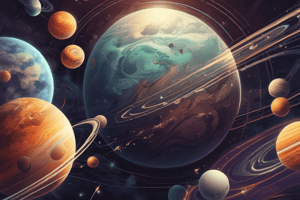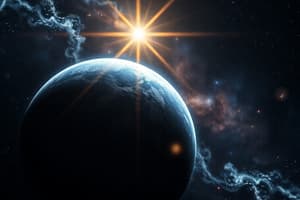Podcast
Questions and Answers
What is the reason for the coincidence of the Sun and the Moon appearing to be the same size in the sky?
What is the reason for the coincidence of the Sun and the Moon appearing to be the same size in the sky?
- The Sun is 400 times larger than the Moon.
- The Moon is actually the same size as the Sun.
- The Moon is 400 times closer to the Earth than the Sun.
- The Sun is about 400 times larger than the Moon and also about 400 times farther away. (correct)
What is the meaning of the term 'eclipse'?
What is the meaning of the term 'eclipse'?
- To block, cover or obscure (correct)
- To magnify or enlarge
- To reveal or uncover
- To reflect or mirror
Why do we not experience a Solar Eclipse every new Moon and a Lunar Eclipse every full Moon?
Why do we not experience a Solar Eclipse every new Moon and a Lunar Eclipse every full Moon?
- Because of the Moon's elliptical orbit around the Earth.
- Because of the Earth's slightly tilted axis.
- Because of the 5° tilt between the orbit of the Moon and the orbit of the Earth around the sun. (correct)
- Because of the Moon's slow rotation on its axis.
What is the meaning of the term 'Gibbous' in the context of the Moon's phases?
What is the meaning of the term 'Gibbous' in the context of the Moon's phases?
What is the term for when the Moon moves directly between the Sun and the Earth, blocking sunlight?
What is the term for when the Moon moves directly between the Sun and the Earth, blocking sunlight?
What is the approximate number of days it takes for the Earth to orbit the Sun?
What is the approximate number of days it takes for the Earth to orbit the Sun?
Why do we experience daytime and nighttime on Earth?
Why do we experience daytime and nighttime on Earth?
What is the term for the plane of the Earth's Equator passing through the center of the Sun, resulting in day and night being equal in length?
What is the term for the plane of the Earth's Equator passing through the center of the Sun, resulting in day and night being equal in length?
Why do we only see one side of the Moon?
Why do we only see one side of the Moon?
What is the term for the longest day of the year or the shortest day of the year?
What is the term for the longest day of the year or the shortest day of the year?
Flashcards are hidden until you start studying
Study Notes
Earth's Rotation and Orbit
- The Earth rotates on its axis once every 24 hours, which is equivalent to one day.
- The Earth orbits around the Sun once every 365.25 days, which is equivalent to one year.
- The extra 0.25 days is accounted for every four years in a leap year, where February has 29 days instead of 28.
Day and Night
- The side of the Earth that faces the Sun experiences daylight, while the side that does not face the Sun experiences nighttime.
- Daytime begins at sunrise and ends at sunset, which corresponds to the Earth rotating towards and away from the Sun.
- However, due to the Earth's tilt on its axis (23.5°), some parts of the world experience constant daylight or darkness during certain times of the year.
Equinox and Solstice
- An equinox occurs when the plane of the Earth's Equator passes through the center of the Sun, resulting in day and night being equal in length.
- A solstice occurs when the Sun is at its highest or lowest point in the sky, resulting in the longest or shortest day of the year.
- The solstices mark the beginning of summer or winter, and the Sun appears to stand still in the sky before changing direction.
Moon's Orbit and Rotation
- The Moon orbits around the Earth once every 27.3 days, which is equivalent to a lunar month.
- The Moon also takes 27.3 days to rotate on its own axis, which is why we only see one side of the Moon.
- The other side of the Moon is called the "dark side of the Moon".
Lunar Phases and Eclipses
- The Moon's orbit is tilted 5° relative to the Earth's orbit around the Sun, which is why we don't experience a Solar or Lunar Eclipse every new or full Moon.
- The Moon is always half-illuminated, but the amount of illumination we see depends on the Moon's position relative to the Earth and Sun.
- The phases of the Moon, including waxing, waning, gibbous, and crescent, are determined by the Moon's position relative to the Earth and Sun.
- An eclipse occurs when the Earth, Moon, and Sun are aligned, resulting in a Solar or Lunar Eclipse.
Studying That Suits You
Use AI to generate personalized quizzes and flashcards to suit your learning preferences.




